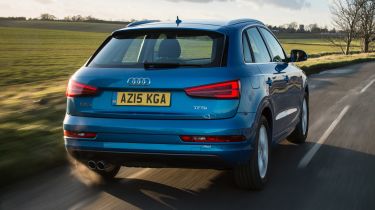Used Audi Q3 review: 2011-2018 (Mk1) - Engines, drive and performance
Lively, economical engines partly compensate for the fact that the Q3 Mk1 isn’t terribly satisfying to drive
‘Nearly but not quite’ is the story of the Q3 Mk1 driving experience. Nearly but not quite comfortable because the ride quality is a touch too firm and agitated. Nearly but not quite sporty because the steering isn’t direct enough and a tad lifeless. On a more positive note, the body doesn’t lean much through corners and there’s plenty of grip from the tyres.
To clarify, though, we’re not suggesting that the Q3 Mk1 is awful to drive. And its deficiencies may not seem great enough to you that you change your decision to buy one. But if you were also to test drive a rival BMW X1, you’d realise that the Audi could be much better.
The powerful RS models are a little more engaging to drive, but not by much. Their appeal lies in their ability to cover ground extremely quickly and securely, thanks to their powerful engines, all-wheel drive traction and strong grip.
The Q3 Mk1 is very quiet inside, however, and its relatively compact external dimensions ensure that it doesn’t feel cumbersome in the traffic or when you’re parking. All its engines are refined, and even the least powerful of them, the 138bhp version of the 2.0 TDI turbodiesel, delivers eager performance.
More reviews
Car trim reviews
In-depth reviews
Road tests
Used car reviews
The sporty-looking S line and S line Plus models feature lowered, stiffer suspension which can feel rather too unforgiving to some people – go for a long test drive to make sure you can live with it.
Which engine should I choose?
For an all-round combination of refinement, performance, great fuel economy and low CO2 emissions, as well as good value and a plentiful supply, the 138/148bhp 2.0 TDI turbodiesel is the pick of the crop. Yes, the extra punch from the 175/182bhp version of the same engine is always nice to have, especially if you frequently lug up and down motorways or tow a caravan or trailer, but you seldom feel the performance deficit of the lower powered models, plus they’re cheaper to run.
In the early days of the Q3 Mk1 there was a 208bhp 2.0 TFSI petrol engine, but buyers treated it with such indifference that it was dropped through lack of interest. The 178bhp version of that engine lived on: it’s pleasant enough and performs quite well, but if you’re going for a petrol engine then the turbocharged 1.4 TFSI is the one to have. Despite being just a 1.4-litre, it produces the peak of its pulling power – or torque – between 1,750rpm and 3,000rpm, which means you don’t have to rev it hard to access the best of its performance. The 1.4 TFSI also features Cylinder-on-Demand technology which can automatically shut down two of the engine’s four cylinders, when appropriate, to the benefit of fuel economy and emissions – some models with this engine give up to 51.4mpg.
Speed addicts are catered for by the RS Q3 and RS Q3 Performance models with their 2.5-litre turbocharged in-line five-cylinder petrol engines. Producing 335bhp in the standard car and 362bhp in the Performance model, this engine is all about furious thrust. It will easily match the most powerful hot hatchbacks for outright performance, while the growl from the powerful turbocharged engine never fails to raise a smile.











